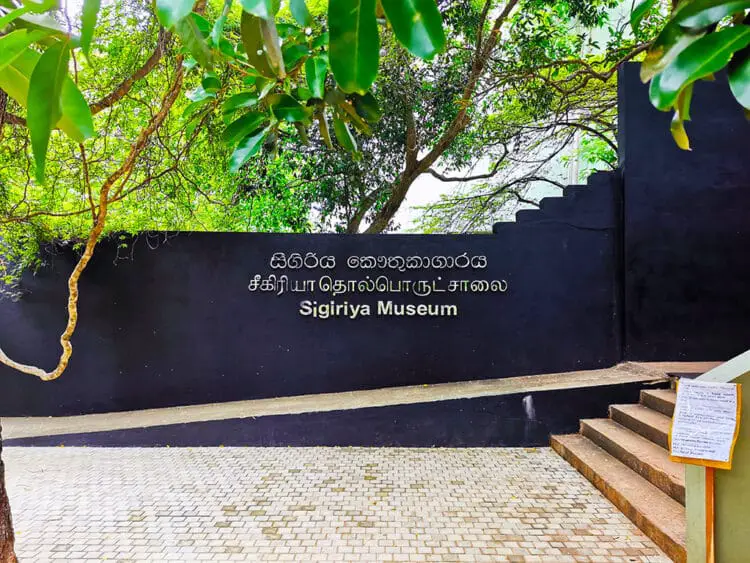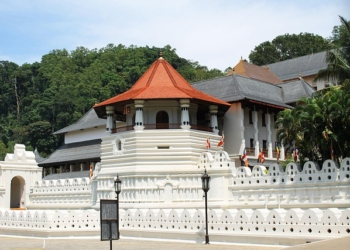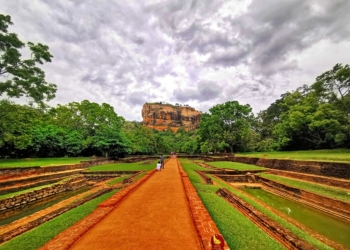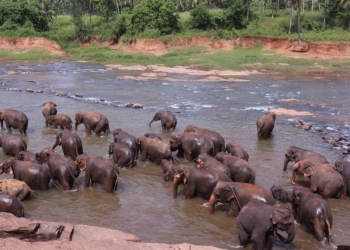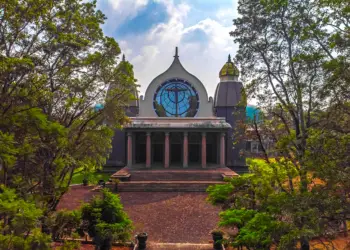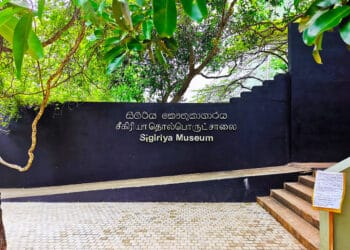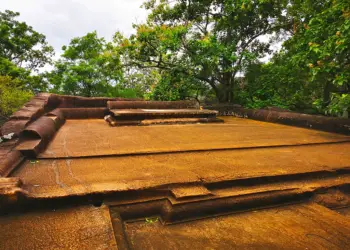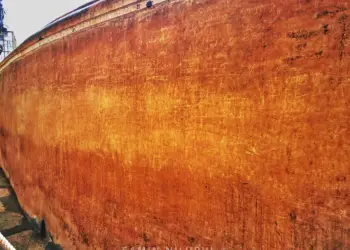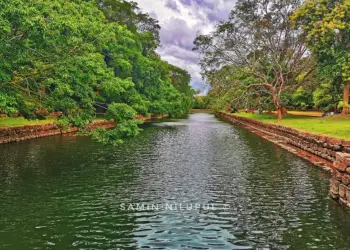Sigiriya is one of the most important tourist attractions in Sri Lanka. Excavations at Sigiriya commenced in 1894 under the Department of Archeology and have been continued since 1982 under the Central Cultural Fund. In addition, a special collection of antiquities found during excavations carried out by the Central Cultural Fund since 1982 has been deposited in the showroom of the Sigiriya Project. Archaeological excavations in the vicinity of Sigiriya lasted for many years until 2009 when a small museum was maintained by the Department of Archeology for public display.With the construction of the new Sigiriya Museum in 2009 with Japanese assistance, the lack of a fully equipped museum at the Sigiriya World Heritage Site came to an end.
Built-in the middle of the Yan Oya in front of the Sigiriya Herbal Garden, this museum is an eco-friendly design. The building was designed by architect Chandana Ellepola. Also, the museum exhibits were designed by the late Prof. Senaka Bandaranaike, the first Director of Archeology of the Sigiriya Project and a former Director-General of the Central Cultural Fund.
The vision of the Sigiriya Museum
To carry the Sigiriya Touched and Untouched Heritage to the people and to act as a community participation centre through modern museum scientific methods, from geological history to contemporary times.
The mission of the Sigiriya Museum
Conducting research on the history and folklore aspects of Sigiriya and the surrounding area, strengthening the interaction between the museum and the people and acting as a centre for imparting knowledge to the people of the area through community programs.


Avoid taking photographs in the Permanent Exhibition Gallery No. 01 (History and Archeology) inside the Museum.


Turn off your cell phone in the museum.


Avoid eating in the museum
Museum Plan
This museum complex looks like three floors and is built on three levels. The building is beautifully designed so that it does not cause any harm to the natural trees in the environment. Several features of the Sigiriya Archaeological site have been added to the building as models. Also, inside the museum, the Sigiriya rock can be seen in several beautiful places.
At the Tourist Rehabilitation Center, three videos in three languages, Sinhala, Tamil and English, will be displayed at the entrance terminal so that visitors can gain a basic understanding of the archaeological background of Sigiriya. Also, the information about King Kasyapa in the Mahavamsa is similarly mentioned on a glass surface in Sinhala, Tamil and English.
The corrugated bridge arch in the water park is designed as a “Time Tunnel” to access the Sigiriya Museum’s gallery. When viewed from the front of the brick arch tunnel, the two TAM inscriptions visible from the other end symbolize the past. On this floor are also permanent showrooms and temporary showrooms.
Permanent Exhibitions
Exhibition Gallery No. 01 (History and Archeology)
The permanent exhibition of the Sigiriya Museum contains antiquities and exhibits from the beginning of the history of Sigiriya to the recent period including the archaeological history of Sigiriya. The exhibition includes archaeological finds not only from the Sigiriya Archaeological site but also from the surrounding areas. Exhibition Gallery No. 01 consists of 6 sections. They are as follows.
Part One
This section contains antiquities related to Sigiriya’s geological history, the earliest known human activities in Sigiriya, the Early Prehistoric Age and the subsequent Iron Age (Early Historical Age) and iron production. The oldest antiquities in the museum, the 6000-year-old human skeleton found in the Sigiriya Pothana rock cave is also on display here. Nearby, various types of stone tools used by these humans are on display.
Information about human settlements from the Early Iron Age (Early Historical Period) after the Prehistoric Age has been found in the Sigiriya area. A group of stone tombs belonging to that period can be seen in the Dambulla Ibbankatuwa Cemetery. One of its stone tombs has been replicated. It also depicts how antiquities were buried in the tombs after the excavations. The pottery and beads found during the excavations are also on display here. One of the iron furnaces belonging to the iron factory found in the Alakolawewa area near Sigiriya has also been added to the exhibition. The model shows the rest of the stove, which was shaped like a lamp chimney.
Part Two
It has been revealed that Sigiriya was a Buddhist temple before and after the reign of King Kasyapa.On display in this section are Buddhist religious antiquities from Sigiriya and the surrounding areas dating back to that time. The artefacts have been found at Sigiriya, Pidurangala, Viharahinna, audangawa and Kaludiya Pokuna monasteries. Two marble plaques similar to the Amaravathi carvings in India found during the excavations at the Pidurangala Dagaba in 1951 are two unique antiquities found here. One of them depicts the Yamaha procession of the Buddha. Eight wedding symbols are also engraved on the outside of the plaque. This is a rare artifact as it has carvings on both sides of the same board. The other is a plaque with 3 Bodhisattva images. There is currently only one piece left with 2 images. These marble carvings are believed to date back to the 4th-5th centuries AD. Apart from a broken head Buddha statue found in the Audangawa area, other Buddha and Bodhisattva statues are made of limestone, which is common in the Sigiriya area. In addition, several small bronze artifacts are on display. The exhibition also includes a seated Buddha statue found at Pidurangala, the womb of a Bodhisattva or deity relic coffin and the Mahameru model found at Sigiriya. Also on display are some sacred foot stones found at Sigiriya and Manikdena. Pottery Bodhisattva images have been found on the Manikdena monastery grounds. They show features dating back to the 8th-10th centuries AD. The group of bricks inscribed with the letters and symbols deposited here were found during excavations in the Dagaba of the Dakkhinagiri Vihara, now known as the Kaludiya Pokuna, near Sigiriya. The limestone statue of a woman at the exit is believed to belong to the goddess Tara. This recorded statue found at Sigiriya has been broken into three parts. It was later preserved and added to the museum exhibition. The goddess Tara is considered to be the energy (wife) of the Avalokiteshvara Bodhisattvas, as stated in Mahayana Buddhism.
Part Three
There is an exhibition of artefacts related to the architecture and architecture of the royal city of Sigiriya. The main exhibit here is a 1: 200 scale Sigiriya Royal City Complex model. This plan gives a clear idea of the design of the parks in Sigiriya’s town plan, the way in which the surrounding rocks are added to the town plan without causing any damage, and the symmetry of the designs on either side of the road in the water park. Apart from this, a video depicting the palace on top of the Sigiriya rock is also displayed here. The exhibition also includes a number of architectural features found during excavations at Sigiriya. Clay tower heads, building decorations, various types of tiles, plumbing well as iron nails of various sizes and iron tools used for agricultural purposes are on display.
Part Four
In this section, non-religious artefacts found in Sigiriya and surrounding areas are displayed. The terracotta statues of women found in the Sigiriya complex are some of the unique antiquities found here. Prof. Senaka Bandara has suggested that these small female statues, which are similar to the female figures depicted in the Sigiriya frescoes, were “souvenir sculptures” prepared for sale to visitors to Sigiriya in the past. In addition, two clay human figures and a part of a female torso found in the Manikdena monastery complex and two human heads made of lime mortar found at Sigiriya are on display. The collection of exhibits also includes canvas copies of paintings in the Sigiriya Stone Garden’s Seat Cave, Naipena Cave and Deraniyagala Caves. A plan depicting the distribution of graffiti on the Sigiriya Mirror Wall is also on display, and technology has been used that allows several graffiti songs to be heard as you approach the plan.
Part Five
The foremost artefact here is the model of the earring jewellery at the Colombo National Museum. Designed to be similar to the original, the earrings are fitted with a magnifying glass that makes it easy to see the delicate patterns of the earrings. The sorting plan of the pottery found at Sigiriya is shown on the display board and only a few related clay pots are added to the exhibition. The most common remnants of foreign vessels are pottery belonging to the Sassanian period of Persia. In addition, parts of various vessels belonging to countries such as the Mediterranean, China and India can also be seen. Among the coins found at Sigiriya are Roman coins, as well as some silver coins with symbols known as “Has Ebu Coins”, the oldest coin in India, dating back to the Mauryan period. Most of the coins found at Sigiriya can be identified as Roman coins. Apart from this, several copper coins belonging to the Polonnaruwa period have also been found in the Sigiriya area. These coins were used by kings Lilavati, Sahassamalla, Sri Dharmasoka Deva and Sri Vijayabahu.
Part Six
In this section, Sigiriya’s 16th century AD to modern discoveries, terracotta, folk art, sculpture, and a Kandyan chief’s head from the Ambulambe area, a lime kiln found in Dambulla, and the main Portuguese exterior found at Sigiriya. These items reveal information about the hidden period at Sigiriya. Also, this section provides insights into the similarities between Sigiriya and Dambulla paintings, as well as the paintings on the outer walls of the Sigiriya Mirror Wall, as well as the research history of Sigiriya.
Exhibition Gallery No. 02 (Painting cave)
In addition to the section above, a model of the Sigiriya Art Cave on the upper floor has also been constructed in the museum. It must be accessed from the field as well as from a spiral staircase. It is the size of a fresco cave on the Sigiriya rock. Among these paintings are tarred and erased paintings. In addition to the permanent exhibition at the museum, temporary exhibitions on themes related to the Sigiriya area and various other themes are held to impart knowledge and entertainment to the tourists. Among the existing exhibitions, hunting methods, traditional kitchen utensils and traditional arts were displayed in the Sigiriya area, and the traditional packaging methods are currently on display. Here, tourists have the opportunity to gain practical experience in accordance with the relevant themes.
Audience Activities
Inside the premises, a mirror wall model has been created for visitors to write their thoughts on a stick, and a drawing program with a theme for small children is in operation. The only female watchtower found at Sigiriya at the exit terminal and a model of the Seven Cobra watchtower found at Sigiriya in the middle of the pond is on display. An active model of a water lily in the water flower garden has also been created near the exit door of the museum.
Tourist facilities at Sigiriya Museum
The Sigiriya Museum, a World Heritage Site, is designed to provide maximum facilities for local and foreign tourists. On average, about 25% of visitors to Sigiriya are foreign tourists and about 70% are local tourists who visit the Sigiriya Museum. An information centre has been set up to provide information about Sigiriya as well as the surrounding area to visitors to the museum, where the information officers provide information on Sigiriya and its surroundings, archaeological sites and accommodation free of charge. In addition, there is a trio of “touch screens” that provide information on the Sigiriya World Heritage Site and other related archaeological sites, tourist attractions, tourist activities as well as accommodation facilities.
This museum has all the facilities for disabled visitors. Wheelchair services for the disabled and an elevator to the upper floor are available, and wheelchairs can be used to view the entire museum.
The eco-friendly museum building has several places to relax and is also a great place to enjoy the environment. The museum has stalled for the purchase of souvenirs, paintings and antiquities, and the Central Cultural Fund also runs a souvenir and publishing shop.
In addition, a series of monthly academic lectures on scholars on a variety of topics will be held free of charge with the participation of invitees, including school students, teachers, public servants and undergraduates in the area, and the lectures will be open to all. Arrangements have also been made to hold cultural performances at the museum’s outdoor theatre, which will provide visitors with an insight into various aspects of local art as well as entertainment.
Opening hours of the Sigiriya museum
7.30 a.m. – 5.30 p.m.
(Final entry 5.00 pm)
Open daily
Sigiriya museum contact numbers – +94 662 286 344
Tickets
Foreign: US $ 30 – Adults
US $ 15 – Children (under 12)
US $ 05 – (Museum only)
Local : Adults – Rs.50.00
For children under 12 years of age and in school uniform, partial tickets will be issued.
To enter the Sigiriya Museum, a ticket to visit the World Heritage City is valid.
